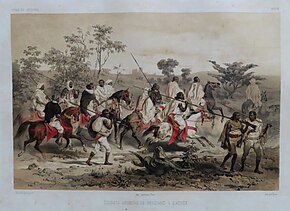
Back Zemene Mesafint Afrikaans ዘመነ መሳፍንት Amharic زمن الأمراء Arabic Zemene Mesafint German Zemene Mesafint Spanish Zemene Mesafent French תקופת השופטים האתיופית HE Zemene Mesafint Croatian Zemene Mesafint Italian Zemene Mesafint NB
| Zemene Mesafint period | |
|---|---|
| 1769–1855 | |
 Ethiopian warriors during the Zemene Mesafint |
The Zemene Mesafint (Ge'ez: ዘመነ መሳፍንት, variously translated "Era of Judges", "Era of the Princes", etc.; taken from the biblical Book of Judges) was a period in Ethiopian history between the mid-18th and mid-19th centuries when the country was ruled by a class of Oromo elite noblemen who replaced Habesha nobility in their courts, making the emperor merely a figurehead.[1] For the most part, the regional lords were tightly related by marriage and constituted a stable ruling elite that prevailed until the mid-20th century. In short, during the Zemene Mesafint, the emperors from the Solomonic dynasty were reduced to little more than figureheads confined to the capital city of Gondar.
The most powerful lords during the Zemene Mesafint were from the House of Yejju, a dynasty that included Ali I of Yejju, Aligaz, Gugsa and Ali II based in Yejju, a region in Wollo. Other regional lords included Kenfu Hailu of Gondar, Ras Dullu Menz, Ras Hailu Yosedeq of Gojjam, Sabagadis Woldu of Tigre, Ras Wolde Selassie of Tigre, Wube Haile Mariam of Simien, and provincial king Sahle Selassie of Shewa.[2]
The lords fought against each other for the expansion of their territory and to become the guardians of the kings of kings in Gondar, the capital of the empire at the time. The monarchy continued only in name because of its sacred character. This nominal but divinely ordained monarchy preserved the dynasty from actual extinction.[2]
The Zemene Mesafint period came to an end when a local outlaw, Kassa Hailu, would challenge the supremacy of the Oromo princes over the Abyssinian kingdom. Hailu gained support from the locals and defeated Oromo lords and princes and would throne himself as Tewodros II, attempting to fulfill a prophecy that a man named Tewodros would restore the Ethiopian Empire to greatness and rule for 40 years.[3][4]
- ^ Abba Bahrey’s Zenahu Legalla: Towards an Ethiopian critical theory - JSTOR. (n.d.-a). https://www.jstor.org/stable/41756933
- ^ a b Shiferaw Bekele, The State in the Zamana Masafent (1786–1853), p. 25
- ^ Gashu Abebe, Semahagn (2016). The Last Post-Cold War Socialist Federation Ethnicity, Ideology and Democracy in Ethiopia. Connecticut, United States: Taylor & Francis. p. 100. ISBN 9781317026327.
- ^ Miller, Stephen (2021). Queen Victoria's Wars British Military Campaigns, 1857-1902. Maine, United States: Cambridge University Press. p. 63. ISBN 9781108490122.
© MMXXIII Rich X Search. We shall prevail. All rights reserved. Rich X Search